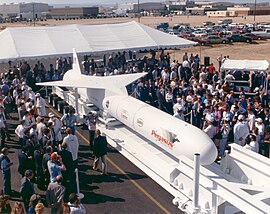Pegasus (rocket)
 |
|
| Function | Launch vehicle |
|---|---|
| Manufacturer | Orbital ATK |
| Country of origin | United States |
| Cost per launch | US$56.3 million (2014) (1994) |
| Size | |
| Height | 16.9 meters (55 ft) (Pegasus) 17.6 meters (58 ft) (Pegasus XL) |
| Diameter | 1.27 meters (4.2 ft) |
| Mass | 18,500 kilograms (40,800 lb) (Pegasus) 23,130 kilograms (50,990 lb) (Pegasus XL) |
| Stages | 3 |
| Capacity | |
| Payload to LEO | 443 kilograms (977 lb) (1.18 by 2.13 meters (3.9 ft × 7.0 ft)) |
| Associated rockets | |
| Family | Air launch to orbit |
| Derivatives | Minotaur-C |
| Launch history | |
| Status | Active |
| Launch sites | Air launch to orbit |
| Total launches | 43 |
| Successes | 38 |
| Failures | 3 |
| Partial failures | 2 |
| First flight | 5 April 1990 (Pegsat / NavySat) |
| Last flight | 15 December 2016 (CYGNSS) |
The Pegasus is an air-launched rocket developed by Orbital ATK, formerly Orbital Sciences Corporation. Capable of carrying small payloads of up to 443 kilograms (977 lb) into low Earth orbit, Pegasus first flew in 1990 and remains active as of 2016[update]. The vehicle consists of three solid propellant stages and an optional monopropellant fourth stage. Pegasus is released from its carrier aircraft at approximately 40,000 ft (12,000 m), and its first stage has wings and a tail to provide lift and attitude control while in the atmosphere.
The Pegasus's three Orion solid motors were developed by Hercules Aerospace (now Alliant Techsystems) specifically for the Pegasus launcher. Additionally, wing and tail assemblies and a payload fairing were developed. Most of the Pegasus was designed by a team led by Dr. Antonio Elias. The wing was designed by Burt Rutan.
Orbital's internal projects, the Orbcomm communications constellation and the OrbView observation satellites, plus Orbcomm-derived satellites (the "Microstar" platform) served as guaranteed customers and additional seed money. Soon after development began, several government and military orders were placed, as the Scout launcher was slated for phaseout.
The first successful Pegasus launch occurred on April 5, 1990 with NASA test pilot and former astronaut Gordon Fullerton in command of the carrier aircraft. Initially, a NASA-owned B-52 Stratofortress NB-008 served as the carrier aircraft. By 1994, Orbital had transitioned to their "Stargazer" L-1011, a converted airliner which was formerly owned by Air Canada. The name "Stargazer" is an homage to the television series Star Trek: The Next Generation, the character Jean-Luc Picard was captain of a ship named Stargazer prior to the events of the series, and his first officer William Riker once served aboard a ship named Pegasus.
...
Wikipedia
